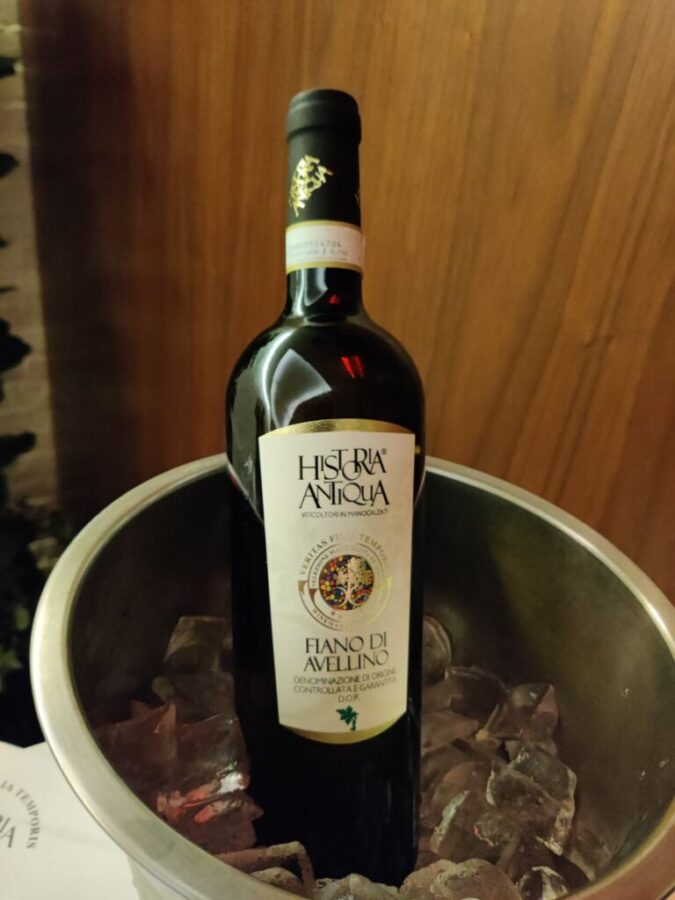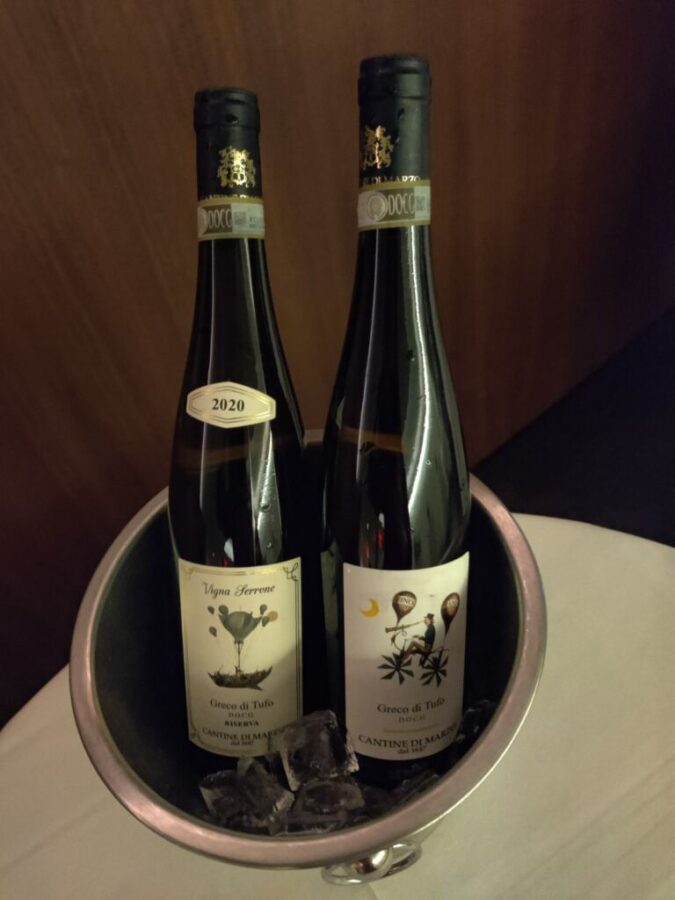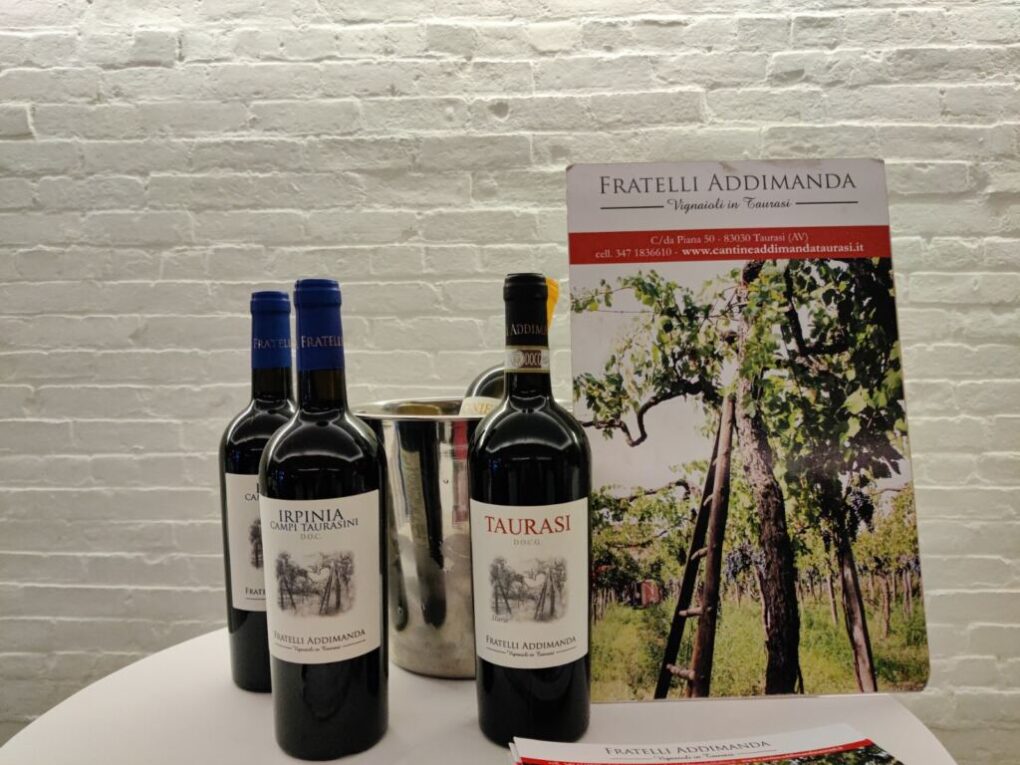
The Consorzio Tutela dei Vini dell’Irpinia, a non-profit organization dedicated to maintaining the exceptional quality standards of food and wine produced in the wine appellation of Irpinia in Campania, celebrates its 20th anniversary this year. It’s also been two decades since Irpinia received DOCG (Denominazione di Origine Controllata e Garantita) status for its principal native white grapes Fiano di Avellino and Greco di Tufo from the Italian government (Irpinia was granted a DOCG for its prized red wine Taurasi in 1993). It’s a lofty accomplishment, and to commemorate the occasions, Consorzio president Teresa Bruno of Petilia winery, and Ilaria Petito from Donnachiara winery, in addition to a number of Irpinia producers came to New York City together for the first time to promote the unique attributes of the land, as well as the Fiano di Avellino DOCG, Greco di Tufo DOCG, and Taurasi DOCG wines crafted from local varietals. The producers also showcased a number of DOC wines including those made from the white grape Falanghina. These local varietals help to distinguish Irpinian wine from those of its neighbors to the north. Wine educator and writer Susannah Gold provided an in-depth overview of the region’s terroir, native grapes, and winemaking history.
Irpnia stands at the foothills of the Southern Apennine mountains in northeast Avellino province. It’s roughly 40 miles from the port city of Naples. Irpinia has an enduring history of winemaking dating back to Roman times. The verdant landscape is marked by valleys and streams surrounded by mountains and hills. The ancient marine and volcanic soil of Irpinia is rich in organic and mineral elements. Temperatures are consistent with the seasons. Summers are hot and dry. Rainfall occurs primarily in fall and winter. All these natural factors come together to make Irpinia ideal winemaking territory.

Fiano di Avellino wines are synonymous with elegance, longevity, and finesse. Fiano is a thick-skinned and naturally acidic white grape that can be produced in both sparkling and still varieties. It’s typically harvested around the second week of October. Fiano vinified in stainless steel tanks tend to be floral, fruit-dominant, and aromatic, while vinification in wood barrels imparts greater structure, body, and complexity.
Fiano di Avellino DOCG wines are fresh, crisp, and medium-bodied, with floral, citrus, and stone fruit, as well as grassy notes. Older Fiano tend to be softer and more structured, and exhibit dried peach, apricot, and fig, as well as acacia, menthol, and balsamic notes.
Greco di Tufo is a subtly aromatic, naturally acidic, and delicate-skinned white grape. It is harvested between the first and third week of October. Greco di Tufo DOCG wines are typically medium or full-bodied, with good structure, acidity, and minerality, and notes of lemon, green apple, and pear, as well as peach, honeysuckle, and nuts. Greco di Tufo is typically vinified in stainless steel tanks. Aging on its lees after fermentation adds richness, creaminess, and weight.
The “riserva” designation was added for both Fiano di Avellino DOCG and Greco di Tufo DOCG in 2020, and to qualify as a “riserva,” Fiano di Avellino DOCG and Greco di Tufo DOCG must be aged for a minimum 12 months. Additionally, there are DOCG designations for both Greco di Tufo “spumante” and Greco di Tufo “spumante riserva.” Greco di Tufo DOCG “spumante” must be aged a minimum 18 months, while a “spumante riserva” must be aged a minimum 36 months. Both the “spumante” and the “spumante riserva” must be produced using the traditional method.
Aglianico is a late-ripening, thick-skinned black grape that has been cultivated in the area since ancient Roman times. Aglianico is the region’s most important grape, and one of Italy’s three principal varietals.
Aglianico adapts well to the terroir in Irpinia. Hot and dry, sun-drenched summers, a landscape marked by hills and valleys of varying elevations (some vineyards are situated at upwards of 450 meters above sea level), as well as calcareous, limestone, and clay soil that is rich in minerals and volcanic elements (vineyards planted close to Mount Vulture tend to produce the best Aglianico- based wines) collectively create the ideal conditions for cultivating native grapes like Aglianico, as well as international varieties such as Merlot and Cabernet Sauvignon,
Aglianico tend to produce full-bodied and structured wines, with considerable acidity and tannins, and bright dark berry and stone fruit, as well as earth, mineral, and dried herb notes. The naturally acidic and tannic quality of Aglianico-based wine softens, and the flavors continue to evolve and grow more complex as the wine ages. Aglianico is produced as both a single varietal and as a blend.
According to DOCG regulations, the prestigious Aglianico-based Taurasi wine must contain a minimum of 85% Aglianico and a blend of up to 15% Sangiovese, Barbera, Piedirosso, or other permitted grapes. Taurasi must undergo a minimum one year oak, and up to two years bottle aging. Taurasi Riserva must be aged a minimum four years.
The masterclass at Il Gattopardo featured some of the best Fiano di Avellino DOCG, Greco di Tufo DOCG, Aglianico DOC, and Taurasi DOCG Irpinia has to offer.
Fiano di Avellino DOCG

The Villa Raiano 2018 was crisp, with a refreshing acidity and sapidity, and white flower, citrus, and orchard fruit, as well as cool mint flavors.

The organic Case d’ Alto, Eclissi, 2017 was fresh, with a balanced acidity, and yellow flower, lemon, and green apple, as well as nutty flavors.
The organic Tenuta Sarno, 2018 Riserva was silky and smooth, with honeysuckle, orchard fruit, and fresh ginger root flavors.
Greco di Tufo DOCG

The Historia Antiqua, 2021 had good acidity and sapidity, and lemon, grapefruit, and pear, along with nutty flavors.
The Petilia Quattro Venti Riserva, 2020 was crisp and fresh, with juicy citrus fruit, along with mineral flavors.

The Cantine di Marzo Vigne Laure Riserva, 2020 had considerable acidity and sapidity, and lemon, grass, and mineral flavors.
Aglianico DOC
The Nativ, 2020 was full-bodied and structured, with balanced tannins, and a supple acidity, as well as mixed dark berry, red fruit, and zesty spice, along with forest vegetation, and chocolate flavors.
The Macchia Santamaria, 2018 was full-bodied, with lively tannins, and young cherry and plum, as well as tobacco flavors.

The Ponterotto, 2018 was characterized by bright blackberry, and cherry, along with leather and fresh herb flavors.
Taurasi DOCG
The Donnachiara Taurasi, 2019 was powerful and rich, with a supple acidity, elegant, well-evolved tannins, and lush red and black berry and fruit, mocha, and espresso, as well as warm spice flavors.
The Feudi di San Gregorio, 2017 was structured and smooth, with soft tannins, and raspberry, blueberry, and blackberry, along with brown spice, and scented wood flavors..

The Fratelli Addimanda, 2014 had good acidity, soft tannins, and dried dark flower, stewed cherry and plum, and tobacco, along with licorice root flavors.

A well-executed lunch by Chef Vito Gnazzo of Il Gattopardo paired well with these wines from the masterclass, as well as with additional selections from these wineries, including a sparkling Greco di Tufo produced using the traditional method, and a number of fresh and crisp Falanghina.

Be First to Comment